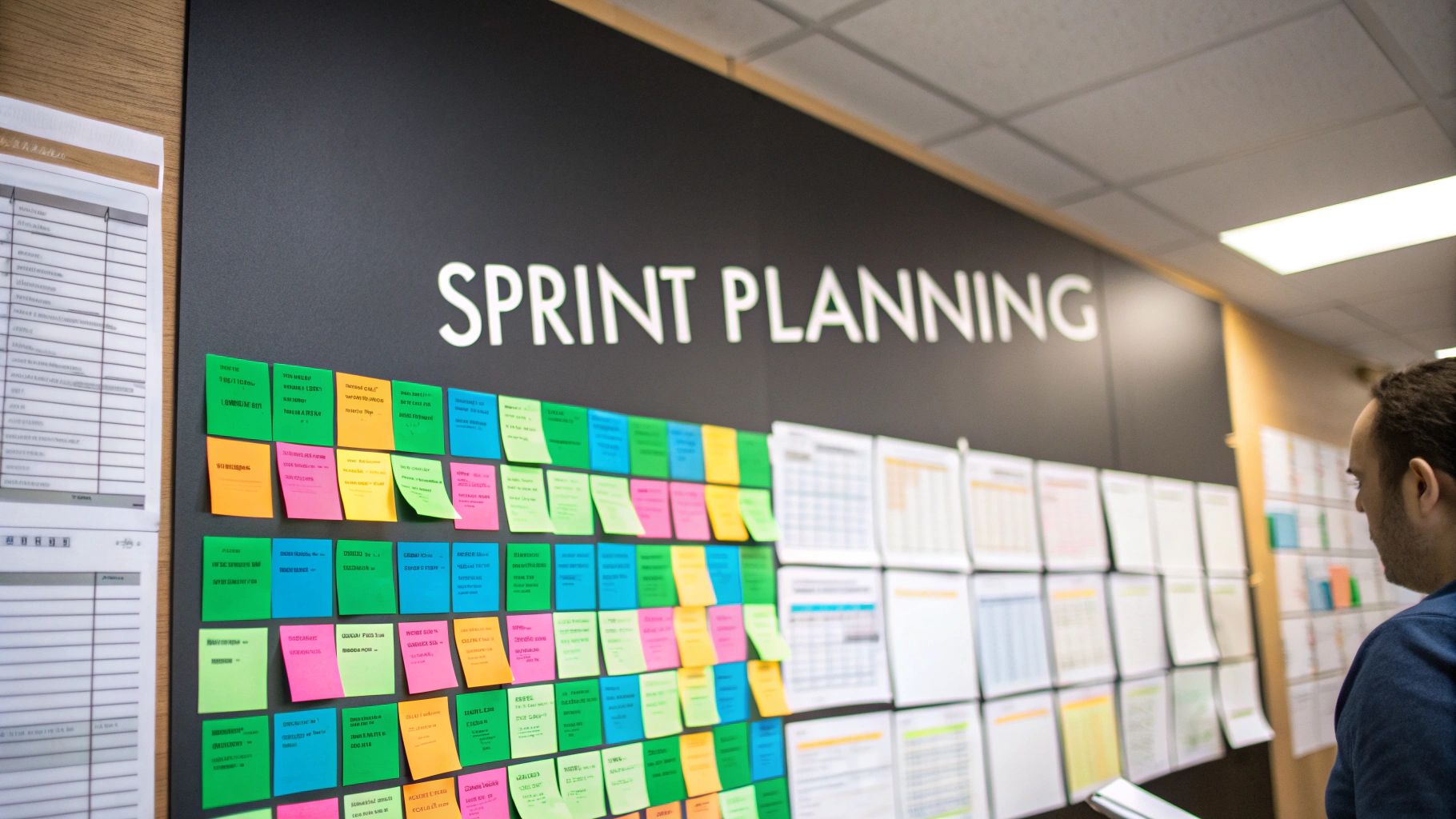Master Agile development with battle-tested strategies that transform team productivity. Learn from industry veterans how to implement Agile practices that deliver measurable results and foster innovation.

The business world continues to grow more complex, with companies facing faster market changes and rising customer expectations. Traditional linear project management approaches often struggle to keep pace with these dynamics. This is where agile methodologies shine - by embracing change rather than resisting it. Companies need ways to adapt quickly as product lifecycles shorten and competition intensifies. The agile approach, with its focus on flexibility and continuous improvement, provides practical solutions to these real-world challenges.
While agile methods began in software development, their principles have proven valuable far beyond tech. Teams across manufacturing, marketing, healthcare and other sectors now use agile practices to handle complex projects and uncertain requirements. The growth of remote and distributed teams has accelerated this adoption, as agile frameworks naturally support collaboration across locations and time zones. For example, marketing teams use agile sprints to test campaign messages, gather feedback, and refine their approach - leading to better results than traditional “big bang” launches.
The widespread adoption of agile brings clear advantages to organizations. Teams using agile methods typically deliver products faster, work more productively, and better satisfy customer needs through regular feedback cycles. According to the 15th State of Agile Report, over 90% of companies now use agile practices - a strong testament to the real-world results. Beyond the metrics, agile builds stronger teams by encouraging open communication and shared ownership. When team members collaborate closely and see their input shape the final product, both motivation and quality improve.
The true power of agile lies in its ability to help teams navigate change. Unlike rigid traditional approaches, agile welcomes evolving requirements throughout a project’s life. This flexibility proves essential when market conditions shift unexpectedly. Think of agile as a ship’s navigation system - it helps teams adjust course while staying focused on their destination. The popularity of Scrum, used by 66% of respondents in the State of Agile Report, shows how teams value frameworks that enable quick responses to change. This adaptability helps companies spot new opportunities early and address risks before they become problems.
Just as adaptability is essential for project success, the Agile mindset forms its foundation. It goes far beyond a simple set of practices to represent a fundamental shift in how teams work together and deliver value. Let’s explore the core principles that make Agile unique and see how this mindset creates real benefits for teams.

The Agile Manifesto outlines four key values that guide teams:
Making Agile work requires building the right environment. Teams need a culture where open communication and trust flourish naturally. For example, team members should feel comfortable sharing honest feedback without fear of criticism. When mistakes happen, the focus stays on learning and improvement rather than blame. This supportive atmosphere encourages people to try new approaches and adapt based on what they learn.
Though Agile began in software development, its principles work well across many fields. Marketing teams use sprints to test campaigns, manufacturing teams apply continuous improvement, and other industries adapt Agile concepts to fit their needs. This broad adoption shows how Agile’s focus on flexibility and customer value resonates beyond tech. Each team can modify Agile practices while keeping the core principles intact. By understanding these fundamentals rather than following rigid rules, teams can shape Agile to work in their specific context while maintaining its essential benefits.

Now that we understand the Agile mindset, let’s explore how Scrum works in practice. Scrum gives teams a concrete way to apply Agile principles like flexibility and customer collaboration in their daily work. It’s no surprise that 66% of teams choose Scrum, according to the 15th State of Agile Report - it provides clear guidelines while remaining adaptable to different contexts. Let’s break down how teams can effectively implement Scrum beyond just theory.
At its core, Scrum organizes work into short cycles called “sprints” that typically last 1-4 weeks. Think of each sprint as a self-contained project with clear goals and deliverables. For example, a development team might spend two weeks building and testing a new feature while gathering user feedback throughout. This focused approach helps teams deliver working software regularly instead of waiting months between releases.
Scrum includes several essential meetings that keep teams aligned and communicating effectively:
While Scrum provides structure, its real power lies in how teams can adapt it to their specific situation. For instance, marketing teams might extend sprint reviews to include focus groups, or remote teams might adjust stand-up timing to accommodate different time zones. The key is maintaining Scrum’s core principles - like transparency and continuous improvement - while adjusting the practices to fit your team’s reality.
This flexibility explains why teams across industries continue choosing Scrum. When adapted thoughtfully, it helps teams consistently deliver value while staying focused on what matters most - meeting customer needs and improving how they work together.

Getting real value from agile development requires more than just going through the motions of daily standups and sprint planning. Teams need to focus on tracking and measuring what truly impacts their success. Simple velocity metrics don’t tell the full story - you need a deeper understanding of how your agile practices are performing. Let’s look at the key metrics that high-performing agile teams track and how they use this data to drive genuine improvements.
While tracking velocity gives you a basic sense of output, it misses crucial elements of team performance. More specific metrics reveal important insights. For instance, cycle time measures how long it takes for work to move from start to finish - shorter cycle times often mean the team is working more efficiently. Lead time looks at the complete journey from customer request to delivery, showing how quickly you’re responding to user needs. These metrics help teams spot bottlenecks and fix process issues that velocity alone wouldn’t reveal.
Quality metrics matter just as much as speed. Teams should track not just the number of defects found in testing, but also assess their severity. Ten minor UI glitches may matter less than one critical security flaw. Regular customer satisfaction surveys and feedback also help ensure you’re building the right features and meeting user expectations. Good metrics balance speed, quality, and customer value rather than optimizing for just one dimension.
The goal isn’t to collect data for its own sake - it’s to fuel real improvements. This connects directly to the agile principle of continuous improvement. When teams regularly review metrics like cycle time, they can identify problem areas and test solutions. If certain types of work consistently take longer, the team can dig into why and experiment with different approaches. Customer feedback shapes future sprint priorities and helps teams stay focused on delivering genuine value. The key is using the data to drive concrete changes.
Tracking the right metrics also helps teams show stakeholders the concrete benefits of agile practices. When you can point to faster delivery times and higher customer satisfaction scores, it builds confidence in the agile approach. This evidence-based view gives stakeholders clarity on what they’re getting for their investment. Being transparent about both successes and areas for improvement creates trust between the development team and business stakeholders. By focusing on metrics that matter - not vanity metrics - teams paint an accurate picture of their progress and the real impact of agile development. This keeps everyone aligned on how agile practices deliver measurable value.
Implementing agile methods brings many benefits, but teams often face real challenges along the way. Understanding and proactively addressing these common obstacles is key to getting the most value from agile practices.
Most teams encounter resistance when first adopting agile methods. Team members who are used to traditional waterfall approaches may feel uncertain about agile’s collaborative and iterative nature. This hesitation often comes from unfamiliarity with new processes or worries about losing control over their work. To address this, teams need open discussions about how agile can help them work better, solid training programs, and an environment where people feel safe trying new things and learning from mistakes. When teams work through this initial resistance successfully, it creates positive momentum for their agile journey.
Working with remote teams across different locations brings its own set of challenges. It’s harder to keep everyone aligned on agile practices and principles when team members are spread across time zones. This can create problems with sprint execution, communication gaps between team members, and confusion about project goals. Teams can overcome these issues by setting clear communication guidelines, using project management software effectively, and scheduling regular online check-ins. For more insights, check out: How to master documentation in agile development.
As more teams within an organization adopt agile, scaling these practices becomes crucial. Moving from single team success to organization-wide agile adoption requires careful planning. Simply copying what works for one team usually isn’t enough. While frameworks like Scaled Agile Framework (SAFe®) provide helpful structure - used by nearly 40% of agile teams - organizations still need to adapt these approaches to their specific needs. Success at scale means managing dependencies between teams, defining clear roles, and keeping everyone focused on shared goals.
Teams face several practical hurdles when putting agile into practice. It can be tough to maintain energy and momentum, especially during long projects. Task dependencies between teams often create bottlenecks. Different team sizes and setups require different approaches - what works for a small office team might not work for a large remote group. For example, while daily in-person standups might be perfect for co-located teams, distributed teams might need different communication methods. Measuring success also presents challenges - looking beyond basic metrics like velocity to focus on customer satisfaction and business value gives a better picture of real progress. Overcoming these obstacles requires good leadership, flexible processes, and staying true to agile’s focus on constant improvement.
Moving to agile development takes careful planning and execution. In this section, we’ll explore how to create a practical implementation plan that fits your team’s needs, selects appropriate tools and processes, and builds the collaborative culture needed for success.
The first step is understanding where your team stands today. Get everyone involved in evaluating current workflows and identifying what’s working well and what needs improvement. Are team members struggling with unclear requirements? Do handoffs between groups create delays? Document these pain points - they’ll guide where you focus your agile transformation efforts. Remember that copying another team’s exact process rarely works. Instead, use these insights to shape an approach that addresses your specific challenges.
Two frameworks dominate the agile landscape: Scrum and Kanban. According to the 15th State of Agile Report, 66% of teams use Scrum, which provides clear roles and regular ceremonies like sprints and daily standups. Kanban focuses on visualizing work and limiting tasks in progress, offering more flexibility. Your choice depends on factors like team size and project complexity. Smaller teams with straightforward projects often do well with Kanban’s simplicity, while larger teams tackling complex work may benefit from Scrum’s structure.
Regular meetings keep teams aligned and moving forward, regardless of which framework you choose. Daily standups help quickly surface blockers and share progress. Sprint reviews give stakeholders visibility into completed work and a chance to provide feedback. Team retrospectives create space to reflect on what’s working, what isn’t, and how to improve. These consistent touchpoints help maintain momentum and keep everyone focused on shared goals.
The right tools make agile practices easier to follow. Project tracking software like Jira, Trello, or Asana helps manage tasks and visualize workflow. Chat platforms like Slack or Microsoft Teams keep communication flowing. Consider adding automated testing and continuous integration tools to speed up development. Focus on tools that work well together and are easy for the team to use.
Success ultimately depends on your team embracing agile principles. Start with clear communication about why you’re making changes and how they’ll help. Provide training to build confidence with new practices. Celebrate early wins to build momentum. Address concerns openly and involve the team in shaping how agile looks in your organization. Create an environment where people feel safe trying new approaches and learning from missteps. This foundation of trust and collaboration is essential for growing an effective agile team.
Streamline your documentation process with DocuWriter.ai and free up valuable development time. Our AI-powered tools automate code and API documentation, ensuring accuracy and consistency while saving you time and resources. Explore the benefits of DocuWriter.ai today and discover how it can enhance your agile development workflow: https://www.docuwriter.ai/